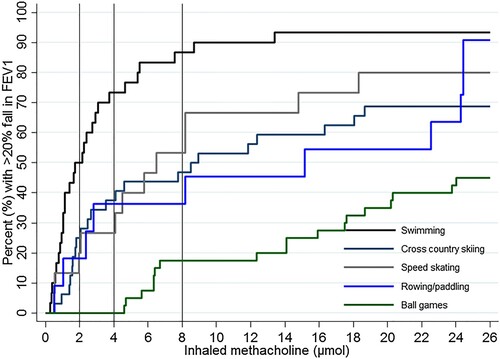Figures & data
Table 1. Descriptive statistics of study participants across the different sports. Results are provided as mean with standard deviation (SD) or numbers (n) with percent of total in parentheses.
Table 2. Lung function of elite athletes participating in different sports. Values are presented in z-scores and Lower Limit of Normal (LLN) according to Quanjer et al. (Citation2012) (Lazovic-Popovic et al., Citation2016).
Figure 1. The distribution of the elite athletes’ responses to increasing cumulative doses of methacholine across the different sports, with a reduction in FEV1 ≥20% as the event of interest. The vertical line shows the diagnostic criteria for severe BHR (PD20met ≤2 µmol), moderate BHR (PD20met ≤4 µmol) and mild BHR (PD20met ≤8 µmol). The Kaplan-Meier curves differ depending on sport (p < 0.001), with the highest proportion of responding athletes in the swimmers.

Table 3. Allergy, bronchial hyperresponsiveness (BHR), fractional exhaled nitric oxide (FENO), self-reported exercise-induced respiratory symptoms and doctor diagnosed asthma in elite athletes participating in different sports
